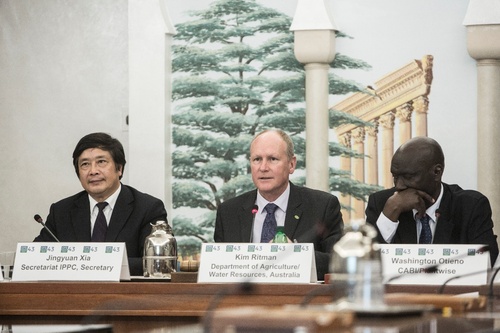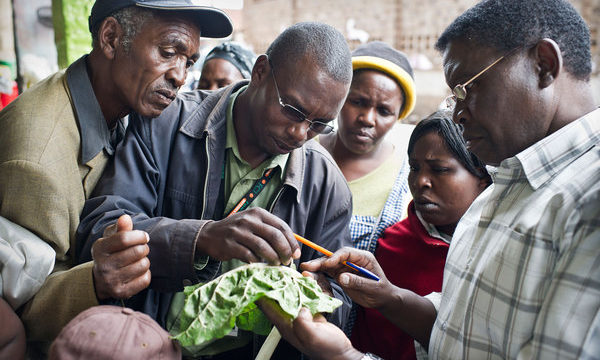
Jingyuan Xia (IPPC), Kim Ritman (Department of Agriculture and Water Resources of Australia) and Dr Washington Otieno (CABI); © IPPC
The side event was co-organized by the Secretariat of the International Plant Protection Convention (IPPC) and the Department of Agriculture and Water Resources of Australia with a manifold success. The side event was held during the 43rd Session of the Committee on World Food Security (CFS43) on 18 October 2016, and marked an important event for plant health awareness promotion. The side event was chaired and opened by Mr Jingyuan Xia, the IPPC Secretary; and five distinguished panelists convincingly presented the links between the plant health and food security, including Mr Kim Ritman (Department of Agriculture and Water Resources of Australia), Mr Washington Otieno (CABI), Maria Saponari (Italian National Research Council and CIHEAM), Mr Rui Cardoso Pereira (FAO/IAEA), and Mr Craig Fedchock (IPPC).
In his opening address, Mr Xia stressed that healthy plants means healthy crops; a prerequisite for food and feed availability for smallholder farmers. Healthy crops also mean less loss, providing smallholders with surplus produce to sell and increasing their economic standing. But healthy plants are only healthy if there is a constant and scientifically accurate surveillance to determine the pest status of a country. By knowing the pests present or absent in a country, governments are enabled to rapidly respond to new detections; this also facilitates trade as it provides for trust between trading partners, and consequently market access. Open and transparent markets translate into economic opportunities and are part of long-term strategies to eradicate poverty and improve food security.
- © IPPC
- © IPPC
- © IPPC
In their presentations, the five panelists demonstrated that surveillance underpins all plant-health related activities and is essential to protecting plants from economically harmful pests. They highlighted the crucial need to prevent the entry and spread of devastating pests because many of these pests cannot be eradicated and the costs are significant. They also explained how governments are supported through the normative work carried out under the auspices of the IPPC to develop harmonized surveillance programmes and measures. The IPPC extends its mission to the national and regional levels through international cooperation with research and capacity development organizations such as CABI and CIHAEM, and other UN agencies such as IAEA.
In addition to demonstrating the crystal clear links between healthy plants and enhancing food security and eradicating poverty, the side event also confirmed that we can hope to meet the Sustainable Development Goals only if we protect the world’s plant resources through a consolidated effort and a cohort voice.
The IPPC Secretariat will continue building partnerships and seeking opportunities to strengthen the role of plant health in the future, aiming at an International Year of Plant Health in 2020.
Reblogged from the IPPC blog. Read the original article here→
Related News & Blogs
CPM-12 adopts a record number of new tools for protecting plants from pest spread
The new standards cover topics such as cold treatments for Mediterranean fruit fly on citrus. Photo ©Daniel Feliciano – CC BY-SA 3.0 This week we’ve been reporting from the 12th session of the Commission on Phytosanitary Measures, which successfully dr…
11 April 2017






